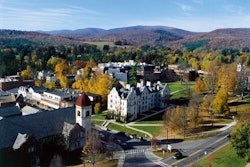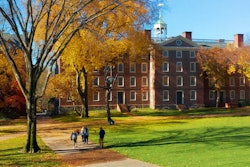IS HIGHER EDUCATION READY FOR MINORITYAMERICA?
Census 2000 data shows an increasing browning of the U.S. population
By RONALD ROACH
A steady stream of Census 2000 data is informing Americans of a radically changing U.S. population. Huge increases in the Latino and Asian American populations are said to be changing the complexion of the nation. There is no doubt the complexion of American campuses will undergo significant change in this decade. Higher education officials have been bracing for a massive influx of students in the 18-to-24-year-old cohort over the next several years.
A 16 percent jump, or nearly five million, in the nation’s total 18-to-24-year-old population group from 2001 to 2015 is heralded by Census data. This growth, known as the baby boom echo, will result in a college enrollment increase of 1.6 million by 2015, according to the U.S. Department of Education. Of that 1.6 million, 80 percent will be non-White, and 50 percent will be Hispanic. Education officials say a majority of the new students will hail from low-income families.
While higher education officials say there is enough space to handle the growth, it’s not clear to some whether higher education institutions are culturally and financially prepared to accommodate the influx of minorities into community colleges, and colleges and universities. The ongoing debate around affirmative action and the moves to restrict remediation education in university systems have made a number of higher education and public officials nervous about what is in store.
“I think everyone’s aware of the numbers, but whether (we) are prepared for them is another issue,” says Dr. William Harvey, vice president and director in the office of minorities in higher education at the American Council on Education in Washington.
Dr. Yolanda Moses, president of the American Association for Higher Education in Washington, says that while elite private colleges, such as Ivy League schools, and historically Black institutions have demonstrated proficiency in recruiting and retaining minority students, “it’s not clear that other campuses are cognizant that they have populations they have to pay attention to.”
In the 1980s and 1990s, majority White colleges and universities went through a period where they focused heavily on recruiting minority students yet paid little attention to retention, according to Moses.
“The challenge in this decade is with retention success and graduation of students,” Moses says.
A major part of increasing student retention will depend on how institutions establish academic climates that are comfortable for minority students, notes Moses.
“A student will leave a campus first because he or she feels unwelcome before leaving because of financial reasons,” she says.
Harvey of the American Council on Education questions whether non-minority serving institutions are getting prepared to handle the influx of minority students in the coming years.
“My immediate concern would be whether students of color have places where they can be accepted,” Harvey says.
Harvey cites incidents of racial unrest at Northeastern University and Penn State University as examples of unresolved tension in American higher education. He fears that predominantly White institutions are far from institutionalizing measures that would create more tolerant and open campuses.
Moses says the move by the California regents to reverse the resolutions banning race-conscious affirmative action in the University of
California system represents a symbolic action that should help minority students admitted to UC schools feel more welcome in the system.
“You had minority students admitted to UCLA and to Berkeley, and they didn’t enroll because they didn’t feel welcome. That’s a climate
issue,” Moses says.
“The reversal by the regents is saying the UC system is ready to
receive (underrepresented) minority students,” she adds.
THE FINANCIAL DIMENSION
Another significant concern expressed by higher education officials about the coming influx of minority students is the financial aid picture. Dr. Jamie Merisotis, president of the Institute for Higher Education Policy, says current state and federal policies show too little investment in need-based financial aid programs.
“I don’t think we are well-prepared for dealing with the increases in student populations in the near future,” Merisotis says.
With the vast majority of the new students in higher education projected to be minorities, Merisotis contends their demographic profile will require a larger investment in financial aid programs than is currently the case. In a U.S. Department of Education advisory committee report released in February, it was noted that federal Pell Grants, the government’s principal aid program for low-income college students, cover only 39 percent of the cost of attending a four-year public college, down from 84 percent in the mid-1970s.
Merisotis worries not so much about whether campus environments will be welcoming of minority students, but whether financially strapped private and public institutions with demonstrated success in recruiting and educating minorities will be able to provide need-based financial aid.
Merisotis contends there are numerous public and private majority White schools that may be forced to seek wealthier and Whiter student bodies to survive in the coming years.
“I worry about the institutions that want to educate minorities but don’t have the financial resources,” Merisotis says.
He adds that many minority-serving institutions are faced with the dilemma of wanting to do more for their populations but contend with serious financial constraints.
Dr. Michael Lomax, president of Dillard University in New Orleans, says he sees the community of historically Black institutions well positioned to grow their enrollments with academically competitive African American students, but fears that only a few schools will have the means to do so.
Over the past few years, historically Black institutions, such as Dillard, Benedict College and Florida A&M University, have increased their enrollments and made financial aid available for their new students.
Lomax says Dillard’s enrollment went from 1,549 students in 1997 to 1,953 students in the 2000-01 academic year. During the same period, annual financial aid awards have increased from $2 million to $5 million, according to Dillard officials.
“We’ve made a substantial investment in enrollment management and financial aid,” he says.
Lomax adds that over the past four years, Dillard’s growth has enabled the institution to successfully attract Black students from California so much so that Californians represent the third-largest state contingency after Louisiana and Texas. Four years ago, Dillard enrolled virtually no students from California, according to Lomax.
“This is a robust opportunity for HBCUs. (Young Black students) are favorably disposed to HBCUs. But not every HBCU is capable of increasing their enrollments to meet a higher demand,” Lomax says.
“This is a time when American philanthropy could make a huge difference.”
© Copyright 2005 by DiverseEducation.com





















